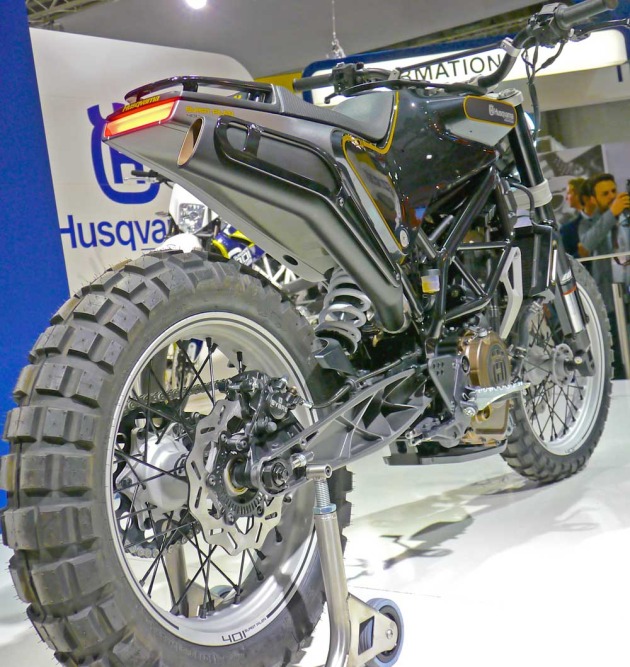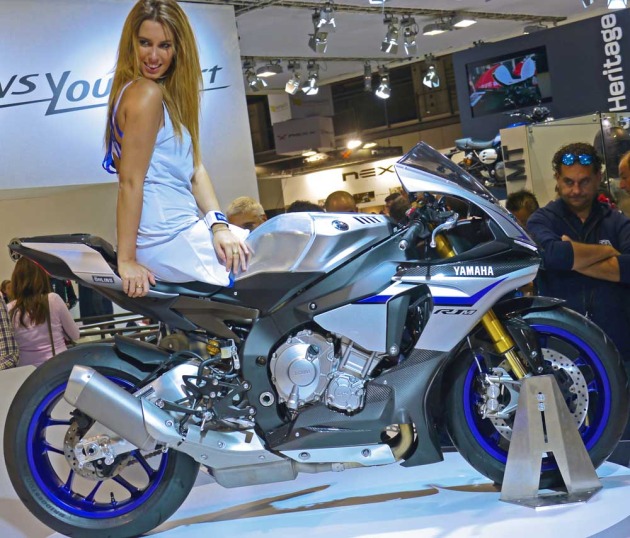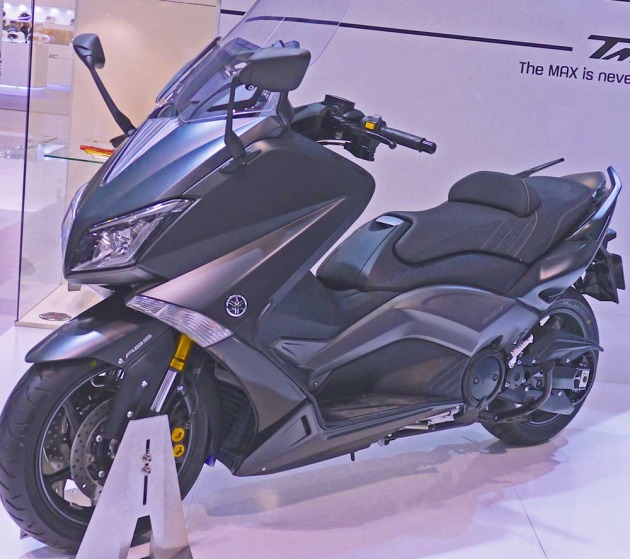New Bikes unveiled by Manufacturers at Milan?s EICMA Show
New Levels of Superbike Performance and Technology displayed
Last Friday, we posted Part One of our EIMCA preview from Milan, Italy. Ty van Hooydonk, director of Discover Today?s Motorcycling and a senior advanced instructor for the Motorcycle Safety Federation attended this year?s iconic show and was gracious enough to serve as our correspondent and to supply us text and photos offering an early look at some of the more significant examples of the amazing crop of new bikes making their debut at the gigantic Fiera Milano convention center.
The annual International Motorcycle Exhibition in Milan, Italy is officially known as the Esposizione Internazionale Ciclo e Motociclo e Accessori, or more simply the EICMA Motorcycle Show. This year marked the 72nd edition of the EICMA Show, which happens to be the biggest motorcycle show in the world, with the most new-bike unveilings as well as the largest floor plan. Over 1,000 manufacturers of riding machines, gear and accessories from 35 different countries exhibit their wares at this legendary show each year.
All-new or heavily updated big-engine sport bikes dominated the model unveilings this year. Japanese and European brands held nothing back, rolling out the highest-performance, most technologically advanced two-wheelers ever seen in the now show?s 100-year history.
Several machines on display boasted manufacturer-claimed outputs of 200 horsepower or more for the nearly half million paying attendees, Electronic rider aids from lean-sensitive ABS to automatically adjusting active suspension, and bike-to-smartphone connectivity, were included on an ever increasing range of machinery. Certainly beyond imagination a century ago, such technological features will be on sale for everyday consumers next year.
A total of 24 machines comprise our preview. Part One featured the first 12, and here is a look at the remaining group of twelve showcasing what will be available coming up to ride in the 2015 model year, keeping in mind that not all of these machines, and certainly not the concept models, have been announced for the U.S. market, and prices have yet to be set for many of the production machines.
PART TWO
Husqvarna 401 Svartpilen concept

The 401 Svartpilen is the second concept and represents Husqvarna?s take on a next-generation scrambler. Knobby-shod spoke wheels, a stubby front fender, trellis frame and black, megaphone-type muffler deliver an old-school aura, but the unified tank/seat cover, caged LED headlamp, modern WP suspension, disc brakes, and state-of-the-art, liquid-cooled, four-stroke, single-cylinder let?s one know that it?s a 21st century design. Minimalist tail and tank racks hint at packing up for adventure, both on-road and off. Don?t expect to see the 401 Svartpilen (Swedish for ?black arrow?) in a local dealership soon, although enthusiastic response at shows and online, just might encourage Husqvarna to put something like it into production.
The street version of Kawasaki?s new supercharged hyperbike, the Ninja H2 has a few engine modifications, along with intake and exhaust systems tailored for noise and emissions regulations, however it shares basically the same powerplant as the track-only H2R version. Kawasaki stated the R model as having 305 horsepower, while the street H2 has only 207. Visually, the main differences begin with the muffler, now an angular, gold-hued assemblage where before a smaller, MotoGP-style megaphone once existed. The large wings, atop the fairing nose on the R version, have been replaced by some of the most advanced mirrors ever made for a motorcycle. The mirror arms feature airfoil cross-sections, designed by Kawasaki?s aerospace firm. Their trailing edges feature Gurney flaps that improve the efficiency of the airfoils, generating more downforce with a smaller surface. Just beneath those mirrors, the carbon fiber finish seen on the R model?s fairing has been replaced with more of the black-chrome mirror paint common to the ?tank? (it?s really an air box cover) on both bikes. Advanced electronics that help the rider manage 200-plus horsepower include: traction control; selectable engine maps; launch control; engine braking control; a quick-shifter; electronic steering damper; and advanced ABS. Many of these systems have an off switch, allowing the highly skilled rider to have more control. The asking price for the Ninja H2 is $25,000. And Kawasaki is taking orders now.
It seems that more naked bikes are making the scene these days, in virtually all displacement categories, and the Ninja 300 has been stripped of some of its plastic shrouding to create the new Z300. A tubular handlebar replacing the Ninja?s clip-ons, greets the rider, providing a more upright riding position. Underneath, the same fuel-injected, 296cc parallel twin reaches incredibly high revs and a slipper clutch eases lever effort and makes for slicker downshifts. An ABS model is available as well. No word yet if either bike will be sold on our shores to compete with Honda?s new naked CB300F.
While some of the latest entry-level bikes have recently grown, from 250cc to 300cc, and even to 320cc in some cases, Kawasaki isn?t forgetting the traditional quarter-liter class. The newest Ninja is a super-slim, 250cc single-cylinder sport bike with an appropriate SL designation for its super-light weight. With a listed curb weight of only 332 pounds, the SL is 44 pounds lighter than the old twin-cylinder Ninja 250. Kawasaki claims a healthy 27 horsepower for the liquid-cooled, double-overhead-cam, fuel-injected four-valve motor. It?s nestled in a nicely triangulated trellis frame, which is sadly hidden underneath the sleek bodywork. ABS is optionally available. Entry-level riders who want a bike that?s easy to handle, or experienced enthusiasts who remember the old days of tiny, high-performance 250s, the 250SL is a nice addition to the Ninja lineup.
The KTM 1050 Adventure is the newest addition to KTM?s adventure-touring lineup that subscribes to the less-is-more approach. That translates to less weight (nearly 40 pounds lighter than the 1290 Super Adventure), and narrower tires than its stable-mates for easier handling, as well as a lower seat height. For many riders, the 1050 means a more manageable 95 horsepower as opposed to the 160 horses produced by the big 1290. The 1050?s cast wheels require less maintenance, and the tubeless tires are simpler to plug in the event of a puncture. KTM literature makes a point about lower purchase and ownership costs, but the 1050 still boasts top-shelf WP suspension, selectable power modes along with ABS and traction control, which can be disengaged for off-road use. The 1050 is the Austrian firm?s entry-level ADV machine, that?s well loaded and capable with its LC8 V-twin powerplant.
KTM isn?t new to electric bikes, but the Austrian firm will offer three electric-powered motorcycles for the first time in the European market. The E-SM is the supermoto variation, aimed at riding in urban environments where the long-travel WP suspension units will aid in soaking up potholes. The bike?s sticky 17-inch street tires, slim chassis and low 242-pound weight should also make for easier navigation of crowded city streets. KTM claims one full hour of maximum power for the E-SM, with presumably added time on the road if less throttle is used. The lithium-ion battery powers a brushless, permanent magnet motor and twin disc brakes handle stopping duty. There?s no clutch or transmission needed. A single direct drive is all it needs. KTM will also sell an E-SX off-road model and an E-XC dual-purpose bike, both similar in appearance to the E-SM model.
The Eldorado returns to the Moto Guzzi lineup again, some four decades after the original debuted. Based on the California 1400 first seen at EICMA two years ago, the new variation brings back the classic chrome knee panels and twin pin-stripes from the original Eldorado. New 16-inch spoke wheels and whitewalls recall the past, as well, along with the retro tail light and bullhorn handlebars. The new seat height is only 28.5 inches off the deck. Just like in the 1960s, power comes from a Guzzi-traditional 90-degree V-twin, longitudinally mounted and driving the rear wheel via drive shaft. But that powerplant now has fully modern, electronic traction control and offers three power modes to choose from.
British bike builder Triumph, updated its four model lineup of Tiger 800s, all with updated, 94-horsepower, three-cylinder engines that deliver better fuel economy. The middleweight adventure-touring models display a new look, with freshened radiator shrouds, tank side panels, adjustable seats and handlebars, and windscreens that need no tools for changing their positions. All of the Tigers have switchable ABS, which can be turned off for off-roading, along with traction control, which also has an off switch. The Tiger 800 XR is more for road work with lower suspension and cast alloy wheels. The Tiger XC focuses more on off-road aspirations with more suspension travel and spoked rims. The Tiger XRx and XCx come with more advanced electronics including selectable engine modes and cruise control.
This is Yamaha?s performance scooter that?s been freshened for 2015 with new styling and a few performance attributes to help maintain its performance image. The front forks are now inverted for increased rigidity and improved feel. Brakes are radial-mount types first developed for use on Yamaha?s sport bikes. Underneath the new sleek shell, now with full LED lighting, is a potent 530cc, double-overhead-cam, eight-valve motor with fuel-injection. New convenience features include a 12-volt outlet to accomodate personal electronics, a Yamaha Smartkey system that allows the fob-carrying rider to start the TMAX with a button-push, and higher mirrors for easier maneuvering on cramped European streets. While popular on the Continent, it may be quite some time before the TMAX arrives Stateside.
This new, adventure-styled sport-touring bike will soon be coming to the American marketplace with the FJ-09 alphanumeric name. Its basic 847cc, three-cylinder engine is already in the U.S. market, powering the FZ-09. The MT version is taller, with an adjustable-height fairing, plusher seat and a rear frame ready to accept accessory saddlebags. The FJ?s 4.8-gallon tank swallows a gallon-plus more than on the FZ, making it more suitable for longer rides. The fore/aft adjustable handlebar and height-adjustable seat can make the bike more user-friendly for a variety of rider physiques. The bike also anti-lock brakes and a traction control system, that may be turned off. The U.S. price for the MT-09 starts at $10,490.
Yamaha has completely rebuilt its front-line sport bike for 2015, with expert input from nine-time world champion Valentino Rossi who put in some testing miles for the new 197-horsepower, track-focused R1. Fine metals are used throughout: lightweight titanium connecting rods for high-rev response; light magnesium wheels and rear subframe; aluminum for the twin-spar frame, and now the fuel tank as well. The bike?s weight is 439 pounds with fluids and with fuel in the slim new tank. The R1?s staggering software is more advanced than the hardware, with a race-developed, six-axis Inertial Measurement Unit that monitors lean angle and chassis attitude to help control traction, slides, front-wheel lift and even braking balance on the ABS-equipped bike. The new R1 does retain something from its predecessor: the ?crossplane? crankshaft design and its uneven firing order, for engine pulses that help traction and deliver that distinct engine note. According to Yamaha, the YZF-R1 will be priced at $16,490, available in February.
Following a trend for some upscale brands, Yamaha is building a pricier, limited-production, track-focused version of its new R1 sport bike. Along with the extra M in the model nomenclature, this bike will come with active, electronically controlled suspension, superlight carbon fiber bodywork and high-spec tires from Bridgestone, who supplies tores for MotoGP racing. As on the standard R1, the Inertial Measurement Unit monitors the force and speed of every motion the bike makes, but on the M model, the suspension, front and rear, is instantaneously adjusted, after quickly calculating the ideal compression and rebound damping. The M also features a Communication Control Unit so riders and teams are able to analyze lap times and track data on an Android-based tablet. Bike settings can be wirelessly changed with an app. An R1M mechanic?s toolbox now needs to include not only wrenches but a keyboard as well. The go-fast goodies add $5,500 to the price of a regular R1, which means the M model comes to $21,990. With February availability. The YZF-TR1M will be the Yamaha?s new Superbike racing contender.
Perhaps next year some of us can attend this iconic show
 Arv Voss is a Northern California based freelance motoring Journalist and member and past officer of several noted Automotive Journalist organizations who contributes regularly to a number of national and international media outlets. He reviews not only cars, trucks and SUVs, but motorcycles as well.
Arv Voss is a Northern California based freelance motoring Journalist and member and past officer of several noted Automotive Journalist organizations who contributes regularly to a number of national and international media outlets. He reviews not only cars, trucks and SUVs, but motorcycles as well.



















